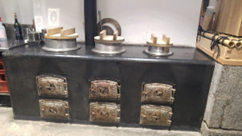Celebration and Kyoto cuisine registered as an intangible cultural property VOL.Ⅱ
(2) Kyoto Cuisine and Okudosan: The History of Kyoto that Emphasizes Fire Sources
Yoshie Doi
 Fukuyoshi restored Okudosan Restoring the 120-year-old Kyoto townhouse |

Yakimochi Tenjindo’s Okudosan |
In Kyoto, there is a custom of placing importance on the source of fire. One of the old customs of Kyoto is to cook ozoni on New Year’s Eve. When the New Year’s Eve bells start ringing, we make a pilgrimage to Yasaka Shrine. “Okera-bi” is a cypress fire hammer and a fire mortar used by Gon-guji, who has been praying since the night before at the time of the tiger (5:00 a.m.) on the 28th. , it is a sacred fire that is put out and transferred to the “Okera lantern”. On the 31st, the fire will be moved to the Okera in the lantern. It is customary to catch the sacred fire on a match rope called Kiccho-nawa and take it home to cook New Year’s zoni and celebrate New Year’s Day.
Okera is a perennial medicinal herb that is used as a stomachic in Chinese medicine. It seems that it is also in the new year’s toso. It wards off evil spirits and is also effective against epidemics, so it is a custom to pray for the expulsion of evil spirits, and can be said to be a ritual of renewal of fire. When we welcome the new year, we will update the banked coal.
Speaking of a banked coal fire, when they asked Toji Temple in the Muromachi period (Oei 10, 1403) for permission to operate “Ippuku Issen” (cafe), ”Don’t use the fire for burning incense as a kind of fire for the tea kettle, and don’t use the water of Akai (well water prepared for the Buddha).” There is a contract content, and they can see the awareness of protecting the sanctuary of the fire.
In the history of Doki Kawabata, a Kyoto confectionery, it is written that “the fire of a banked coal of Emperor Meiji’s birth bath was the Okudosan of Doki Kawabata’s residence, and that the banked coal fire was brought to the residence of Nakayama. Even today, at Iemoto and companies that use fire, fire-burning manju is distributed to staff and employees during the fire-burning festival.The custom of giving thanks to fire is rooted in Kyoto.
In Kyoto, the river that flows through Kamigamo Shrine is called Mitarai River and Nara no Ogawa with different names, and when it leaves the precincts, it is called Myojin River. It’s a Kyoto-like way of naming, but here is the reason why Kyoto is Kyoto. It is the so-called commitment.
Even overseas, Native Americans light a torch before ceremonies to show respect for heaven and earth, north, south, east and west. This fire is called grandfather fire and is said to watch over people. It is a custom believed to renew one’s reverence for the four natural elements of the earth: fire, water, air, and earth.
There is a saying among Native Americans that “a culture that goes against nature is a barbaric culture”. Does it mean to live close to nature, not to deny modernization?
Okudo-san, which has been used continuously in Kyoto, has a long-established store that has been used for 1,000 years, and a restaurant that has been restored and started to use, thermodynamically, it still shines with its charm that gas and electricity do not have.
The end of document
